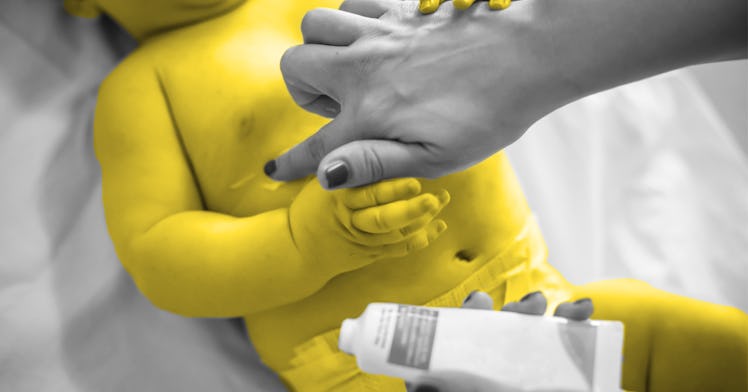How to Recognize and Treat Baby Acne
Nobody want to see a blemish on their newborn, but baby acne is more common than many new parents might suspect.

Baby acne is often unexpected. As parents fawn over their perfect and adorable (if kind of wrinkly and gross) newborn, the presence of baby acne can come as a surprise. But baby skin is notoriously sensitive and influenced by birth hormones, which don’t only affect moms. There are actually several kinds of baby acne, according to pediatrician and board-certified dermatologist Dr. Tsippora Shainhouse: neonatal acne, which appears between two-to-six weeks and resolves by three-to-six months; and infantile acne, which develops by three to six months and later. Parents who know the difference can react appropriately.
“There are technically two ‘types’ of neonatal acne,” Shainhouse explains. “The first is benign cephalic pustulosis, which presents as non-follicular pink bumps and sometimes pustules on the scalp, forehead, cheeks, and chin. It is actually caused by yeast on the skin, and can be managed with gentle washing with soap and/or topical anti-yeast shampoo or cream.”
Pustules are small pimples or blisters that are filled with pus. It sounds gross, but they’re really just small bumps. Babies can be susceptible to a number of skin issues — some harmless, some not — that can be resolved with careful bathing.
The second type of acne is neonatal or true acne. “It presents as follicular comedones (blackheads and whiteheads), pink bumps, pustules and sometimes nodules,” says Shainhouse. Nodules are enlarged deep pimples. “It is related to excess androgens, usually from the mom. It can also be related to androgenic meds that the mom took during pregnancy. Mild cases will resolve on their own. More moderate cases can be treated with topical acne meds.”
Baby Acne Facts
- Pimples are common: many newborns get small pimples or pink bumps due to yeast on the skin. It usually resolves on its own, or with gentle washing or anti-fungal creams.
- Acne is deep: true acne is in the follicles. It tends to manifest around two-to-six weeks (for neonatal acne) or three-to-six months (for infantile acne.)
- Acne is caused by hormones: androgens are male hormones, and they can cause breakouts. Hormone activity is usually normal in newborns and babies.
- Acne is a good reason to talk to a doctor: in most cases, acne and pimples will resolve on their own, but for persistent or severe cases, parents should contact their pediatrician.
Infantile acne develops in babies three to six months of age and older. It is actual acne and develops in the follicle. It features the same sort of symptoms as neonatal acne – the blackheads and whiteheads, pink bumps, pustules, and nodules – and it, too, seems to be associated with elevated androgens. It’s more common in boys.
“Severe cases can lead to permanent scarring and should be managed with oral medications, if appropriate,” cautions Shainhouse. “Over-the-counter ingredients such as salicylic acid or benzoyl peroxide are usually effective for more mild cases. More moderate and severe cases require prescription medications.”
A pediatrician can determine the best course of treatment, and it may be best to keep them in the loop in case the acne is related to another condition. Androgens are male hormones; both men and women produce male and female hormones naturally. So it’s pretty normal for mother and child to have some hormonal activity after birth. Infantile acne usually resolves by two years of age, but it can persist into adolescence. Even throughout childhood, in the case of infantile acne, it’s not usually associated with an underlying condition without accompanying symptoms such as precocious body hair or body odor.
A pediatrician may want to consider a workup for underlying issues with the adrenal gland or hormones while also checking for premature puberty and genetic syndromes if symptoms point to a specific prognosis.
This article was originally published on